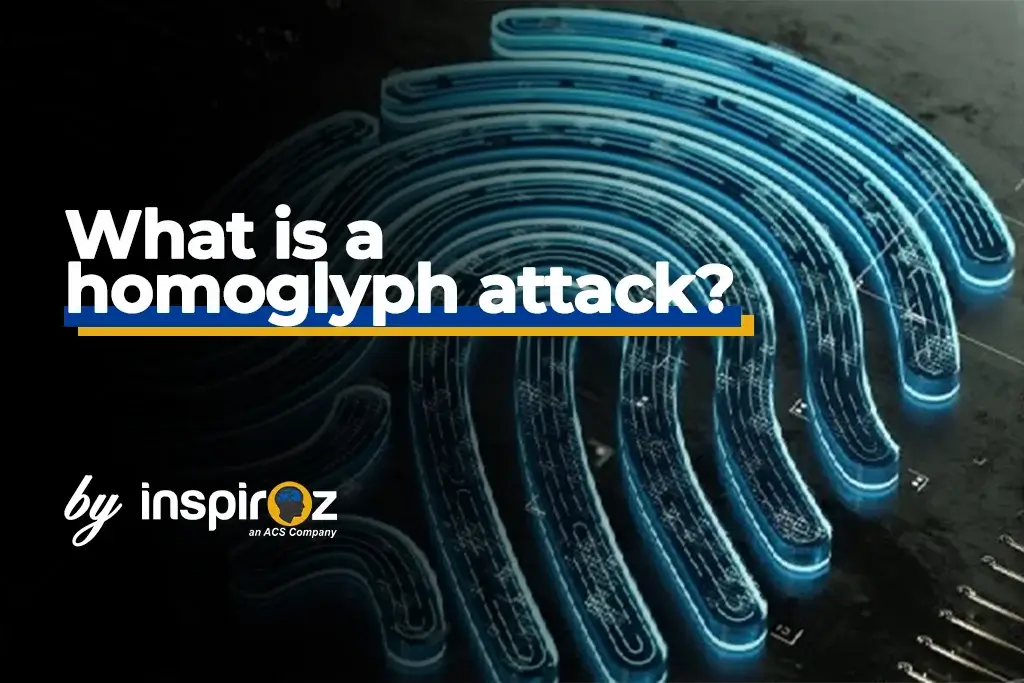What is a Homoglyph Attack?
A homoglyph attack involves substituting visually similar characters—known as homoglyphs—in URLs, email addresses, or other text-based identifiers.
The intention is to deceive the victim into believing that they are interacting with a legitimate source, such as a trusted website or email, while in reality, they are being lured into a malicious setup.
This form of attack leverages the human eye’s inability to detect subtle differences between similar-looking characters.
For example, the Latin letter "O" (U+004F) and the Cyrillic letter "О" (U+041E) may appear identical, but they are different characters encoded differently by computers. Attackers use this visual similarity to craft deceptive domains, emails, and user credentials, making it difficult for users to recognize the fraud without close inspection.
The Latin alphabet is used for many Western languages, such as English, Spanish, and French, and consists of familiar letters like A, B, C, and O.
The Cyrillic alphabet, on the other hand, is used in languages such as Russian, Ukrainian, and Bulgarian. While some letters in Cyrillic look similar or identical to Latin letters (like “A” and “O”), they can have different pronunciations and are encoded differently by computers, which can lead to confusion in cases like homoglyph attacks.
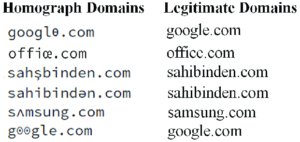
The Mechanics of a Homoglyph Attack
Homoglyph attacks are a subset of visual spoofing attacks, often executed through the following methods:
1. Domain Name Spoofing
Attackers register domains that visually mimic trusted ones by substituting characters with homoglyphs.
For example, the domain “amazоn.com” (using Cyrillic “о”) may appear identical to “amazon.com” in most fonts but leads users to a fraudulent site.
This technique, commonly called typosquatting, often tricks users into divulging sensitive information like login credentials or payment details.
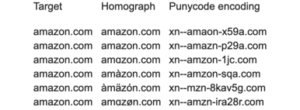
Email Address Spoofing
Homoglyph attacks also target email addresses, where attackers replace characters to make an email address appear legitimate. An email from “suppоrt@school.edu” (with a Cyrillic “о”) may bypass a quick glance but direct communication with malicious actors. This method is particularly dangerous for educational institutions that rely on email for communication between students, teachers, administrators, and even parents.
Credential Phishing
When users enter login credentials on a fraudulent site, homoglyph attacks can capture sensitive information. Attackers can then use this data to launch further attacks, such as accessing critical systems, exfiltrating sensitive data, or performing identity theft. This form of phishing is particularly insidious in the education sector, where students, faculty, and staff may not be as aware of cybersecurity threats as those in corporate environments.
URL Redirection and Hyperlinks
Attackers can embed homoglyph URLs into legitimate-looking emails or websites, leading users to malicious sites when clicked. These homoglyph URLs might be linked with malware downloads, fake login pages, or fraudulent payment portals, exploiting the users’ trust in seemingly legitimate links.
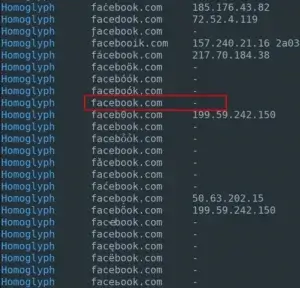
The Impact on Educational Institutions
Educational institutions are particularly vulnerable to homoglyph attacks for several reasons.
Firstly, they handle a significant amount of sensitive information, including student records, financial data, and research.
Secondly, with the rise of remote learning and cloud-based platforms, there is a heavy reliance on digital communication and online collaboration tools. This combination of factors creates an environment ripe for exploitation by cybercriminals.
1. Data Breaches
A homoglyph attack can serve as an entry point for larger data breaches. Once attackers have access to email accounts or other internal systems, they can move laterally through an institution’s network, potentially compromising sensitive student or faculty data.
Data breaches in the education sector can lead to identity theft, financial loss, and long-term reputational damage for institutions.
2. Financial Fraud
Educational institutions often handle tuition payments, grants, and other financial transactions online.
A homoglyph attack could redirect payments or cause users to unknowingly send money to fraudulent accounts. This type of fraud can cause significant financial harm and disrupt operations within an institution.
3. Loss of Trust
Trust is crucial in the education sector, where schools and universities must maintain the confidence of students, parents, faculty, and the community.
A successful homoglyph attack can erode this trust, particularly if the attack leads to a publicized data breach or financial loss.
Institutions may find it difficult to recover from such an incident, both in terms of reputation and stakeholder confidence.
4. Disruption of Learning and Operations
Homoglyph attacks may also result in operational disruptions. If a key system or online platform is compromised, students may lose access to learning materials, exams may be delayed, or critical administrative functions may be hampered.
Given the reliance on technology in modern education, such disruptions can have a cascading effect on the academic calendar and institutional functioning.
How to Mitigate the Risk of Homoglyph Attacks
To protect against homoglyph attacks, cybersecurity professionals in the education sector must adopt a proactive approach.
Below are several strategies and best practices that institutions can implement:
1. User Awareness and Training
One of the most effective ways to mitigate the risk of homoglyph attacks is by educating users. Teachers, students, and administrators should be trained to recognize homoglyph attacks, avoid phishing attempts, and verify URLs and email addresses carefully. Institutions can conduct regular cybersecurity awareness campaigns and simulations to ensure users remain vigilant.
2. Implementing Multi-Factor Authentication (MFA)
Multi-factor authentication (MFA) adds an extra layer of security to user accounts by requiring more than just a password for access.
Even if attackers capture a user’s credentials through a homoglyph attack, they would still need a second factor (such as a mobile authentication app or biometric data) to gain access to the account.
3. Domain Monitoring and Registration
Educational institutions should actively monitor domains that closely resemble their own. Automated tools are available to detect when similar-looking domains are registered.
By identifying and potentially acquiring these domains preemptively, institutions can prevent them from being used in homoglyph attacks.
4. Email Security Protocols
Implementing email authentication protocols such as SPF (Sender Policy Framework), DKIM (DomainKeys Identified Mail), and DMARC (Domain-based Message Authentication, Reporting, and Conformance) can help protect against email spoofing.
These protocols ensure that emails are legitimately from the sender they claim to be and can prevent many forms of homoglyph attacks that rely on email deception.
5. Browser and URL Filtering
URL filtering technologies can help block access to known or suspected malicious sites. By maintaining up-to-date blocklists of homoglyph domains and integrating them with web security solutions, institutions can reduce the likelihood of users accidentally visiting fraudulent sites.
6. Digital Certificates and HTTPS Enforcement
Institutions should ensure that their websites are secured with valid SSL/TLS certificates and enforce HTTPS connections.
This prevents attackers from creating fake, unencrypted versions of the site that may trick users into thinking they are on a secure page. Moreover, users should be educated to look for the padlock symbol in the address bar to verify the legitimacy of a site.
How to spot homoglyphs?
Spotting homoglyphs can be challenging, as they exploit the visual similarity between characters from different scripts or fonts.
However, with careful inspection, awareness, and the right tools, it’s possible to identify homoglyphs and prevent falling victim to attacks that use them.
Here’s how you can spot homoglyphs:
1. Carefully Inspect Characters
Homoglyphs are designed to look almost identical to familiar characters, so spotting them requires close attention to detail. Here’s what to look for:
Character Shape: Focus on characters like “o” (Latin) and “о” (Cyrillic), “a” (Latin) and “а” (Cyrillic), or “l” (lowercase L) and “I” (uppercase i).
These small differences can be easily overlooked, especially in URLs or email addresses.

Font and Size: Some homoglyphs only appear identical in certain fonts or at specific sizes. Try changing the font size or style in your browser or text editor to reveal the differences.
Actionable Tip: When checking URLs or email addresses, enlarge the text or switch between different fonts to see if the characters change appearance.
2. Use Online Homoglyph Detection Tools
There are online tools specifically designed to detect homoglyphs. These tools analyze text or URLs and highlight characters that may be homoglyphs. Some examples include:
- Homoglyph Detector: A browser-based tool that allows you to enter URLs or text to check for homoglyph characters.
Unicode Character Analyzers: These tools break down strings of text by Unicode points, making it clear whether visually similar characters belong to different character sets.
Actionable Tip: Use a homoglyph detection tool whenever you encounter a suspicious URL, email, or message that seems slightly off, especially in critical interactions.
3. Check the Full URL Before Clicking
Homoglyph attacks often target domain names. You can spot suspicious domains by carefully analyzing the full URL, especially the part before the “.com,” “.edu,” or other top-level domains.

For example, a malicious URL might use “amazоn.com” (with a Cyrillic “о”) instead of “amazon.com.”
- Hover Over Links: Instead of clicking directly on a link, hover your mouse over it to view the full URL in the browser’s status bar. This helps you verify the actual destination before engaging with it.
- Use Browser Security Features: Modern browsers, like Chrome and Firefox, have built-in protections against homoglyph domains. They may flag or block suspicious URLs automatically.
Actionable Tip: Always check the URL in the browser’s status bar before clicking. If the domain looks unusual, especially with mixed scripts, it could be a homoglyph attack.
4. Use Unicode Character Information
If you are unsure whether a character in a URL or email is legitimate, you can check its Unicode value to determine whether it belongs to the correct script. Each character on your keyboard corresponds to a specific Unicode point, and homoglyphs exploit different Unicode points with similar visual appearances.
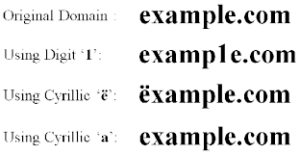
Inspecting Unicode Values: By copying a suspicious character and pasting it into a Unicode inspector tool, you can see its exact Unicode point and determine if it belongs to a different script (e.g., Latin vs. Cyrillic).
Actionable Tip: Use tools like Unicode Character Lookup to inspect any suspicious-looking character and compare its actual Unicode code to what you expect.
5. Be Aware of Commonly Spoofed Characters
Certain characters are more commonly used in homoglyph attacks because they look almost identical across different scripts. These include:
The letter “O” (Latin) and “О” (Cyrillic)
The letter “a” (Latin) and “а” (Cyrillic)
The letter “l” (lowercase Latin) and “I” (uppercase i)
Knowing these common pairs can help you be more vigilant when reviewing URLs, email addresses, and other critical strings of text.
Actionable Tip: Familiarize yourself with common homoglyph pairs and stay alert when encountering characters that could be easily substituted.
6. Check for Mixed Scripts
Homoglyph attacks often mix characters from different scripts within a single word to avoid detection.
For example, a domain might contain a mix of Latin and Cyrillic characters to deceive the user visually while maintaining a different code point. To spot these, look for:
- Inconsistent Letter Shapes: A word or domain might appear off if some letters look slightly different from others, as a result of mixing scripts (e.g., Latin “l” and Cyrillic “l” may have subtle differences).
- Language Inconsistencies: If you notice characters from different languages or alphabets in places where they don’t belong (such as a domain name), it could be a homoglyph attack.
Actionable Tip: Use language detection tools or font change methods to identify when scripts have been mixed in text strings.
7. Enable Browser Security Settings
Many modern browsers, including Chrome and Firefox, come equipped with advanced security features that block or warn users about potentially malicious URLs, including those containing homoglyphs. These browsers rely on real-time threat databases and algorithms to detect homoglyph domains.
Actionable Tip: Ensure your browser's security settings are fully enabled, and consider installing browser extensions that provide additional protection against phishing and homoglyph-based attacks.
8. Use Phishing Protection and Anti-Spam Tools
Homoglyph attacks are often delivered via phishing emails. To prevent falling victim to such attacks, use phishing protection tools and spam filters that can automatically detect and flag emails containing suspicious URLs or text.
- Anti-Phishing Tools: Email services like Gmail and Office 365 offer built-in anti-phishing protection, which can automatically detect suspicious homoglyph characters.
- URL Scanners: Use services like Cloudflare Radar to scan suspicious URLs for phishing attempts, including those using homoglyphs.
Actionable Tip: Always double-check emails marked as suspicious by anti-spam or phishing detection tools and avoid clicking on links within those emails.
9. Stay Informed and Updated
Cybersecurity threats like homoglyph attacks evolve, and staying informed about the latest tactics can help you stay ahead. Regularly updating software, email clients, and browser settings can help ensure you have the latest protections in place.
Conclusion
Spotting homoglyphs requires vigilance and attention to detail. By employing a combination of manual inspection, online tools, and security measures, individuals and organizations can protect themselves from falling victim to homoglyph attacks.
Taking steps such as checking URLs closely, leveraging anti-phishing tools, and using Unicode character analysis can significantly enhance your ability to detect and prevent these sophisticated threats.



